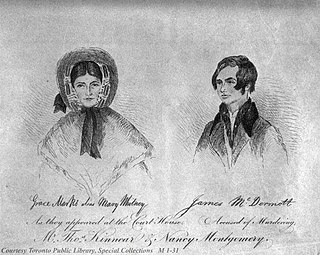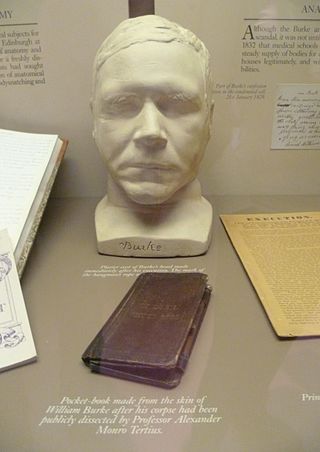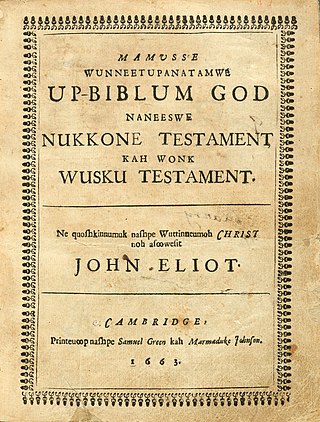
The Scarlet Letter: A Romance is a work of historical fiction by American author Nathaniel Hawthorne, published in 1850. Set in the Puritan Massachusetts Bay Colony during the years 1642 to 1649, the novel tells the story of Hester Prynne, who conceives a daughter with a man to whom she is not married and then struggles to create a new life of repentance and dignity. As punishment, she must wear a scarlet letter 'A'. Containing a number of religious and historic allusions, the book explores themes of legalism, sin and guilt.

Gilbert Stuart was an American painter born in the Rhode Island Colony who is widely considered one of America's foremost portraitists. His best-known work is an unfinished portrait of George Washington, begun in 1796, which is usually referred to as the Athenaeum Portrait. Stuart retained the original and used it to paint scores of copies that were commissioned by patrons in America and abroad. The image of George Washington featured in the painting has appeared on the United States one-dollar bill for more than a century and on various postage stamps of the 19th century and early 20th century.

Grace Marks was an Irish-Canadian maid who was involved in the 1843 murder of her employer Thomas Kinnear and his housekeeper, Nancy Montgomery, in Richmond Hill, Ontario. Her conviction for the murder of Kinnear was controversial and sparked much debate about whether Marks was actually instrumental in the murder or merely an unwitting accessory. Marks was the subject of Margaret Atwood's historical fiction novel Alias Grace and its adaptations in other media.
Auburn Correctional Facility is a state prison on State Street in Auburn, New York, United States. It was built on land that was once a Cayuga village. It is classified as a maximum security facility.

Anthropodermic bibliopegy is the practice of binding books in human skin. As of April 2022, The Anthropodermic Book Project has examined 31 out of 50 books in public institutions supposed to have anthropodermic bindings, of which 18 have been confirmed as human and 13 have been demonstrated to be non-human leather instead.

Samuel Emery Chamberlain was an American soldier, painter, and author who traveled throughout the American Southwest and Mexico during the mid-19th century.
James Allen, also known as George Walton, Jonas Pierce, James H. York, and Burley Grove, was an American highwayman.
John Fenno was a Federalist Party editor among early American publishers and major figure in the history of American newspapers. His Gazette of the United States played a major role in shaping the beginnings of party politics in the United States in the 1790s.

Charles Gibbs was the pseudonym of an American pirate, born James D. Jeffers. Jeffers was one of the last active pirates in the Caribbean during the early 19th century, and was among the last persons to be executed for piracy by the United States.

Samuel Green was an early American printer, the first of several printers from the Green family who followed in his footsteps. One of Green's major accomplishments as a printer was the Eliot Indian Bible, translated by the missionary John Eliot, typeset by James Printer, which became the first Bible to be printed in British America in 1663. Members of his family who also became printers include his sons Bartholomew, Bartholomew Green Jr. and Joseph Dennie. Throughout his adult life Green also served in the Massachusetts Bay Colonial Militia, advancing to the rank of captain later in life.

George Parrott also known as Big Nose George, Big Beak Parrott, George Manuse, and George Warden, was a cattle rustler and highwayman in the American Wild West in the late 19th century. His skin was made into a pair of shoes after his lynching and part of his skull was used as an ashtray.

Charlestown State Prison was a correctional facility in Charlestown, Boston, Massachusetts operated by the Massachusetts Department of Correction. The facility was built at Lynde's Point, now at the intersection of Austin Street and New Rutherford Avenue, and in proximity to the Boston and Maine Railroad tracks that intersected with the Eastern Freight Railroad tracks. Bunker Hill Community College occupies the site that the prison once occupied.

There are two notable reported instances of lampshades made from human skin. After World War II it was claimed that Nazis had made at least one lampshade from murdered concentration camp inmates: a human skin lampshade was displayed by Buchenwald concentration camp commandant Karl-Otto Koch and his wife Ilse Koch, said to be with other human skin artifacts. Despite myths to the contrary, there were no systematic efforts by the Nazis to make human skin lampshades; the one displayed by Karl-Otto Koch and Ilse Koch is the only one confirmed.

Massachusetts House of Representatives' 8th Hampden district in the United States is one of 160 legislative districts included in the lower house of the Massachusetts General Court. It covers part of the city of Chicopee in Hampden County. Democrat Joseph Wagner of Chicopee represented the district until 1991. Upon his retirement, Democrat Shirley Arriaga has taken over as Representative.

Dark Archives: A Librarian's Investigation into the Science and History of Books Bound in Human Skin is a 2020 non-fiction book by the medical librarian and death-positive advocate Megan Rosenbloom. Dealing with anthropodermic bibliopegy, the binding of books in human skin, it expounds upon Rosenbloom's research on such books and their historical, ethical, and cultural implications.

Victor Folke Nelson was a Swedish-American writer, prisoner, and prison reform advocate. He spent many years incarcerated in both the New York and Massachusetts prison systems and came to the attention of neurologist Abraham Myerson and penologist Thomas Mott Osborne for his potential as a writer. In 1932, Nelson published his book Prison Days and Nights with the assistance of Dr. Myerson.
Warden is the surname of:
Death at Midnight: The Confession of an Executioner is a 1996 non-fiction book by Donald A. Cabana, published by Northeastern University Press. Cabana was the warden of the Mississippi State Penitentiary in Sunflower County, Mississippi. After his term, he spoke against the death penalty.

Frank C. Almy was an American convicted murderer hanged by the state of New Hampshire for killing a woman in Hanover, New Hampshire, in July 1891.














